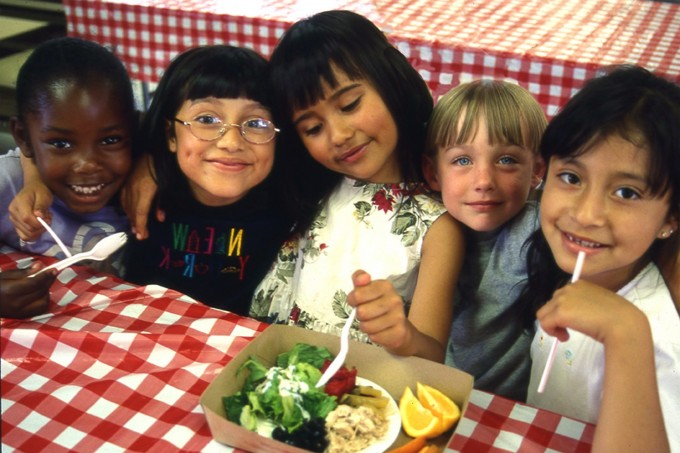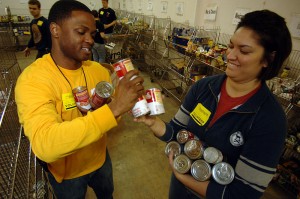When funds are tight, giving can remind us how much we have, and how fortunate we are. While coming face to face with money problems can be a challenging experience for any of us, being able to do something about it offers our kids a chance to step into responsiveness instead of reactivity. This sense of empowerment is key to facing the global reality of have and have-not with compassion instead of fear.
The power to create solutions, even in small ways, is both a learning opportunity and a healing act that serves both the person giving and the one receiving. Most of us have been in both of those positions at times in our lives. According to the National Center for Children in Poverty, 22% of kids in the US are living in poverty, and 45% are living in low income households. The facts about child-poverty are challenging, but demystifying poverty – giving the struggle a face, and a place in consciousness – will help your children to become part of the solution. And knowing how to plug in to the system of support will also give your kids confidence that in the roughest times, people still show up for each other.
What does this have to do with Witchcraft and faith? Many things. First is that many religious organizations have charitable paths. Many of our circles and churches do not – so solitary acts are often the way that we can plug in. Another is that many of us believe that what we give out to our community is in some way going to come back to us. And third, the idea of light in darkness – or hope in lean times – is perhaps one of the primary universal spiritual offerings. When we take care of our most vulnerable community members we are doing the work of spirit made manifest in the world.
Additionally, acts of service can be integrated into your family traditions. Lent for Catholics, Ramadan for Muslims, and the winter holiday season for many, charitable acts are an integrated part of seasonal worship.
For many of the more devout, acts of giving are an integrated part of ongoing worship and religious devotion.
A concern to be addressed in participating in acts of service is that the process of helping carries a danger of a savior mentality. The options I’m offering here are designed to bring you into authentic relationship with members in your community who are going through rough times. The ideal is that these experiences of solidarity will allow a process of humanization and connection, and awareness that we are all in this struggle together.
A few things to remember in the course of service work is that you cannot force people to accept your help. Your service is – ideally – for others, not to gratify your own ego or sense of need. This being the case, don’t over-attach to outcomes, to feeling good, to being well-received. Some people do not want your help. This may be rooted in their own sense of pride, or it may be mistrust about your intentions. (You have no idea how many people offer a helping hand while expecting something in return.)

Also, coming from a place of collectivism is going to lower the possibility of any sense of power-tripping or grandiosity that may come from offering help. The truth is that many of us are one paycheck away from homelessness. Many in our community, myself included, have experienced homelessness in our lives. So, “There but for the grace of God (or the gods) go I,” is not an empty sentiment in my heart, nor in my home. It is important to remind our kids that sometimes we have more than we need, and when we do we offer the extra out. And sometimes we have less than we need, and when we do we can ask for help.
If you have come here to help me, you are wasting your time.
But if you have come because your liberation is bound up with mine, then let us work together.
– Aboriginal activists group, Queensland, 1970s
Explain this to your kids in advance.
Here are some ways that you and your children can participate in an engaged relationship based in giving with each other and members of your community over the holidays, and throughout the year.
1. Cull/weed household belongings and give the extras away
An easy starting point is to cull or weed your household goods. Suggest that your kids do the same. Have them decide what they’re willing to part with to help a kid in need. Choose the best from the lot, and offer these items out.
Many shelters will take used toys and clothes. Call your local shelter and see what they’re willing to take. If you’re flush you can throw in some new items. Take your kids to the dollar store (or a local shop if you have more disposable income) and buy a handful of travel toothbrushes and paste, travel-size toiletries like hand soap or sanitizer, disposable razors and travel-size shaving cream, socks, and hats. For $40 you can purchase a haul that goes a long way. If you have a little more to spend, go to the local thrift store and pick up a few coats, jackets, or sweaters.
Allow your kids to lead this discussion, and for sure don’t push your kids into something they aren’t ready for, but if your kids are ready for the experience they may want to go to the drop-off with you. When my older kid was 11 she asked me to bring her with on her first drop off. If anything, it was anticlimactic. We went to the back of the shelter in the evening and left our donations with an employee. But there’s no way to know how intense the experience might be.
In whatever case, make sure you’re ready to have as many conversations as your kids need to have to process these experiences.
2. Offer items directly to homeless community members
If your kids are a little bit older and you already have a relationship with the homeless population (like, you go and take food and other items to places where the local houseless folks congregate) you and your kids can take donations directly to those who need it the most, and give it out yourself. This population – folks who are on the street instead of in shelters or other programs – need support more than any others. People who end up on the street get there for all kinds of reasons and are the most likely to have mental health concerns, be actively using drugs and/or alcohol, and have likely lived though things you don’t want to imagine.
That said, if you take the time to nurture connection you will find that these people – just like the rest of us – are grateful for support, connection, and care.
If you’re going to an encampment bring food, and make time to sit down and share it. Bring sweets. Bring single-serving items people can keep for later. Bring fruit. You can bring cigarettes and beer if you feel ok doing so. For me part of the work I do on myself while engaging with homeless community members is about stepping out of judgement and meeting people where they are. If you do bring alcohol and or cigarettes this is a perfect opportunity to talk to your kids about drug and alcohol use and addiction, AND to address judgmental cultural attitudes that make asking for help a challenge, or even possibly grounds for criminal charges in cases of addiction to illegal substances.
Again, if you are going to take your kids into this experience, first build your own connections with full-time camp residents. Make sure you have people who will welcome you into the camp, and introduce you to the rest of the folks gathered there.
This is a whole other level of intensity. Make sure you are ready for the waking up that this kind of experience might deliver for your kids.
3. Host a giveaway/exchange/regifting party with friends and community members – take leftover items to the charity or service of your choice
Knowing that poverty is present in our own homes and family systems makes it essential that we categorize sharing as a response to the stresses of financial struggle.Invite friends and family members to bring gently loved belongings to your home or another suitable space to offer them out for free. While gifting, participants may also take what they need from what others are giving away.
In addition to saving money and time, this is a good way to reduce your carbon footprint. Reusing, regifting, and upcycling takes items out of the trash heap and puts them into use. This reduces waste, and exchanging items also keeps the by-product of an extra shopping trip out of the equation – from saving on gas money to avoiding the extra packaging on new items.
At the end of the giveaway, invite your friends to leave all extra items that they don’t want, and take them to your local shelter or favorite charity – or as discussed above, hand them out to folks who need them yourself.
4. Help your kid come up with ways to give
Food drives, clothing drives, penny drives, quilt drives, coat drives, and more; there are so many ways to help. What are some creative ways your child can come up with to gather resources together and offer them out?
For maximum impact on your kid’s development of their own compass on engaging in service, allow your kid offer ideas and do your best to support them. The more empowered your kid is to participate in giving from their own heart the more organic and integrated the experience becomes.
When my older kid was 11, she decided to bring her change jar – a huge pickle jar with a good start on coins – to her classroom for a change drive. It was her idea, start to finish.
She wasn’t sure where the coins would go, once the jar is full. With a little encouragement from me she decided that her classmates would all bring suggestions of different local charities or services, and the class as a whole would decide together where the money would go.
I suggested that she choose the parameters; local, national, international? And the other guidelines. A charity, a service, a fund? Buy items with the money and give them directly to the local shelter? There are many options.
The by-product of this course of action is that my daughter and her classmates got to research charities and services, and learn about the network of support that one can plug in to, both to receive help and to offer it.
Together, the kids in her class decided to gift the money they all pitched in toward the local soup kitchen.

5. Offer service at your local soup kitchen
or food bank
The soup kitchen in the nearest town to us offers a family lunch service before the general lunch service. While the family service will raise its own questions to be answered, serving families is a great way for kids to come face to face with those they are helping.
And, as a person who ate at that kitchen as a kid, going back to serve there with my kids was both humbling and a cause for deep reflection on gratitude.
Ask the folks who run the kitchen if you can bring a home cooked dish or cookies to contribute to the service. Your child’s sense of generosity and engagement is likely to be even larger if they have had a hand in creating the food they’re offering out.
Food banks can almost always use food donations – especially nonperishable items. They may also need support staff during more high-traffic times. Contact the food bank in your area and see what their needs are, and if you can offer support. Again, dollar stores and outlets stores have great deals on food items if you can’t afford the more high-end items.
And, a BONUS item:
For a few years in a row, my kids and I did what we called “Project Pizza.” We purchased a stack of pizzas, drove around town, and offered pizza to everyone who looked hungry. We went to the food back during distribution, and gave folks waiting in line slices of hot pie. We drove around and looked for kids who were obviously living on the streets and gave them slices. We found the old drunks down by the railroad tracks and gave them slices. We found moms and kids looking haggard from a day of Christmas shopping and gave them slices too.
We haven’t embarked on a Project Pizza outing in a while. Now that my kids are basically grown and have their own lives to manage it’s harder to make time to engaging in community giving together. Maybe this year is the year to recommit.
May your acts of giving serve you, and your family, your community, and may they serve all.
How does YOUR family engage in community giving? We want to know! Share with us in the comments section.
Need Last-Minute, Unique, Caring Gifts for Loved Ones?
Visit my store and make your order now!
Use the code PATHEOS at checkout for 20% off.
Sexy Witch Gift Package, Winter Witch Gift Package, Tea Light Diffuser, Magickal Oils, New Year Coaching Program, and MORE!


















